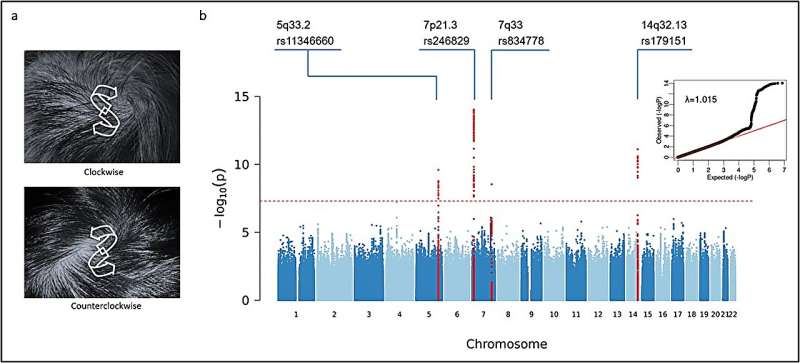This article has been reviewed according to Science X's editorial process and policies. Editors have highlighted the following attributes while ensuring the content's credibility:
fact-checked
peer-reviewed publication
trusted source
proofread
Study shows hair whorl direction has a genetic basis

The first gene mapping study on human scalp hair whorls not only shows that hair whorl direction has a genetic basis, but also that it is affected by multiple genes. Four associated genetic variants that are likely to influence hair whorl direction are identified, as reported in the Journal of Investigative Dermatology.
A hair whorl is a patch of hair growing in a circular pattern around a point specified by hair follicle orientations. As an easily observed human trait, scalp hair whorl pattern is typically defined by the whorl number (single or double whorl) and whorl direction (e.g., clockwise, counterclockwise, or diffuse).
Because atypical whorl patterns have been observed in patients with abnormal neurological development, understanding the genetic basis of whorl patterns may help unravel important biological processes.
The first genome-wide association study (GWAS) on human scalp hair whorls was performed among 2,149 Chinese individuals from the National Survey of Physical Traits cohort, followed by a replication study in 1,950 Chinese individuals from the Taizhou Longitudinal Study cohort.
Lead investigator Sijia Wang, Ph.D., Shanghai Institute of Nutrition and Health, Chinese Academy of Sciences, explained, "We know very little about why we look like we do. Our group has been looking for the genes underlying various interesting traits of physical appearance, including fingerprint patterns, eyebrow thickness, earlobe shape and hair curliness."
"Hair whorl is one of the traits that we were curious about. The prevailing opinion was that hair whorl direction is controlled by a single gene, exhibiting Mendelian inheritance. However, our results demonstrate that hair whorl direction is influenced by the cumulative effects of multiple genes, suggesting a polygenic inheritance."
The study identifies four associated genetic variants (at 7p21.3, 5q33.2, 7q33, and 14q32.13). These genetic variants are likely to influence hair whorl direction by regulating the cell polarity of hair follicles, with cranial neural tube closure and growth also potentially playing a role.
Professor Wang said, "While previous work proposed the hypothesis of associations between hair whorl patterns and abnormal neurological development, no significant genetic associations were observed between hair whorl direction and behavioral, cognitive, or neurological phenotypes. Although we still know very little about why we look like we do, we are confident that curiosity will eventually drive us to the answers."
More information: Journal of Investigative Dermatology (2023). www.jidonline.org/article/S002 … (23)01995-4/fulltext


















